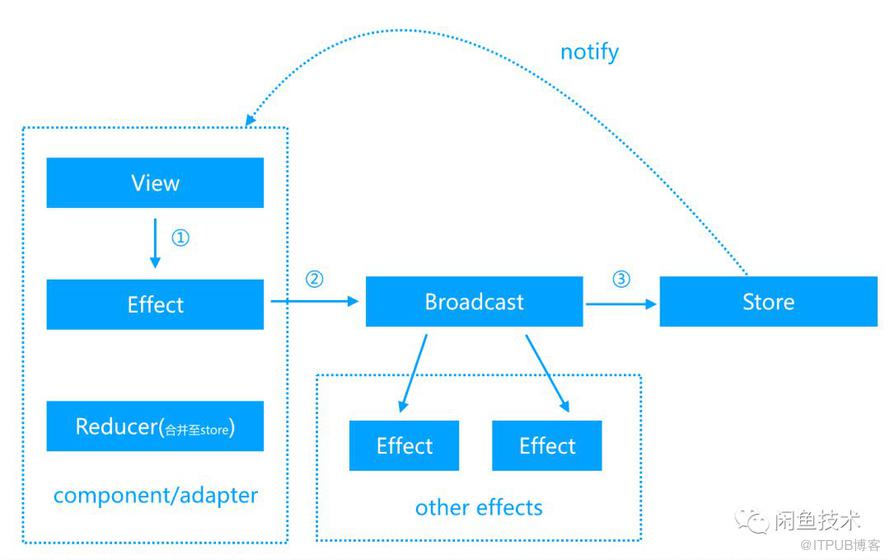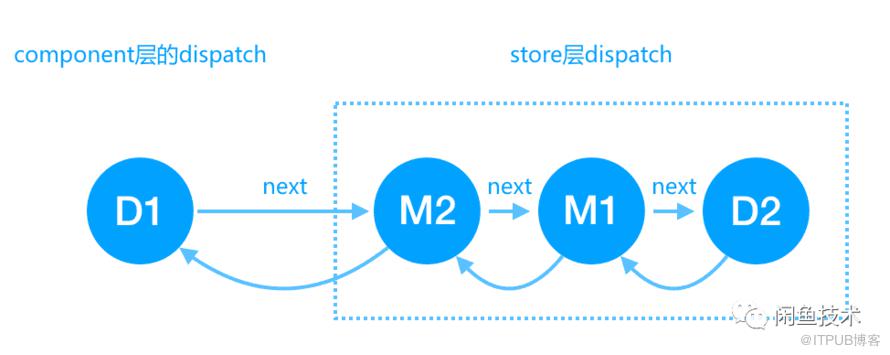这篇文章主要为大家展示了“Fish Redux中的Dispatch如何实现”,内容简而易懂,条理清晰,希望能够帮助大家解决疑惑,下面让小编带领大家一起研究并学习一下“Fish Redux中的Dispatch如何实现”这篇文章吧。
我们在使用fish-redux构建应用的时候,界面代码(view)和事件的处理逻辑(reducer,effect)是完全解耦的,界面需要处理事件的时候将action分发给对应的事件处理逻辑去进行处理,而这个分发的过程就是下面要讲的dispatch, 通过本篇的内容,你可以更深刻的理解一个action是如何一步步去进行分发的。
为了更好的理解action的dispatch过程,我们就先以todolistpage中一条todo条目的勾选事件为例,来看点击后事件的传递过程,通过断点debug我们很容易就能够发现点击时候发生的一切,具体过程如下:
用户点击勾选框,GestureDetector的onTap会被回调
通过buildView传入的dispatch函数对doneAction进行分发,发现todo_component的effect中无法处理此doneAction,所以将其交给pageStore的dispatch继续进行分发
pageStore的dispatch会将action交给reducer进行处理,故doneAction对应的_markDone会被执行,对state进行clone,并修改clone后的state的状态,然后将这个全新的state返回
然后pageStore的dispatch会通知所有的listeners,其中负责界面重绘的_viewUpdater发现state发生变化,通知界面进行重绘更新
Dispatch在fish-redux中的定义如下
typedef Dispatch = void Function(Action action);本质上就是一个action的处理函数,接受一个action,然后对action进行分发。
下面我门通过源码来进行详细的分析。
0component->ComponentWidget->ComponentState->_mainCtx->_dispatch而 _mainCtx的初始化则是通过componet的createContext方法来创建的,顺着方法下去我们看到了dispatch的初始化
// redux_component/context.dart DefaultContext初始化方法 DefaultContext({ @required this.factors, @required this.store, @required BuildContext buildContext, @required this.getState, }) : assert(factors != null), assert(store != null), assert(buildContext != null), assert(getState != null), _buildContext = buildContext { final OnAction onAction = factors.createHandlerOnAction(this); /// create Dispatch _dispatch = factors.createDispatch(onAction, this, store.dispatch); /// Register inter-component broadcast _onBroadcast = factors.createHandlerOnBroadcast(onAction, this, store.dispatch); registerOnDisposed(store.registerReceiver(_onBroadcast)); }context中的dispatch是通过factors来进行创建的,factors其实就是当前component,factors创建dispatch的时候传入了onAction函数,以及context自己和store的dispatch。onAction主要是进行Effect处理。这边还可以看到,进行context初始化的最后,还将自己的onAction包装注册到store的广播中去,这样就可以接收到别人发出的action广播。
Component继承自Logic
// redux_component/logic.dart @override Dispatch createDispatch( OnAction onAction, Context<T> ctx, Dispatch parentDispatch) { Dispatch dispatch = (Action action) { throw Exception( 'Dispatching while appending your effect & onError to dispatch is not allowed.'); }; /// attach to store.dispatch dispatch = _applyOnAction<T>(onAction, ctx)( dispatch: (Action action) => dispatch(action), getState: () => ctx.state, )(parentDispatch); return dispatch; } static Middleware<T> _applyOnAction<T>(OnAction onAction, Context<T> ctx) { return ({Dispatch dispatch, Get<T> getState}) { return (Dispatch next) { return (Action action) { final Object result = onAction?.call(action); if (result != null && result != false) { return; } //skip-lifecycle-actions if (action.type is Lifecycle) { return; } if (!shouldBeInterruptedBeforeReducer(action)) { ctx.pageBroadcast(action); } next(action); }; }; }; }}
上面分发的逻辑大概可以通过上图来表示
通过onAction将action交给component对应的effect进行处理
当effect无法处理此action,且此action非lifecycle-actions,且不需中断则广播给当前Page的其余所有effects
最后就是继续将action分发给store的dispatch(parentDispatch传入的其实就是store.dispatch)
0
// redux/create_store.dart
final Dispatch dispatch = (Action action) {
_throwIfNot(action != null, 'Expected the action to be non-null value.');
_throwIfNot(
action.type != null, 'Expected the action.type to be non-null value.');
_throwIfNot(!isDispatching, 'Reducers may not dispatch actions.');
try {
isDispatching = true;
state = reducer(state, action);
} finally {
isDispatching = false;
}
final List<_VoidCallback> _notifyListeners = listeners.toList(
growable: false,
);
for (_VoidCallback listener in _notifyListeners) {
listener();
}
notifyController.add(state);
};
store的dispatch过程比较简单,主要就是进行reducer的调用,处理完成后通知监听者。
0
// redux_component/component.dart
Widget buildPage(P param) {
return wrapper(_PageWidget<T>(
component: this,
storeBuilder: () => createPageStore<T>(
initState(param),
reducer,
applyMiddleware<T>(buildMiddleware(middleware)),
),
));
}
// redux_component/page_store.dart
PageStore<T> createPageStore<T>(T preloadedState, Reducer<T> reducer,
[StoreEnhancer<T> enhancer]) =>
_PageStore<T>(createStore(preloadedState, reducer, enhancer));
// redux/create_store.dart
Store<T> createStore<T>(T preloadedState, Reducer<T> reducer,
[StoreEnhancer<T> enhancer]) =>
enhancer != null
? enhancer(_createStore)(preloadedState, reducer)
: _createStore(preloadedState, reducer);
所以这里可以看到,当传入enhancer时,createStore的工作被enhancer代理了,会返回一个经过enhancer处理过的store。而PageStore创建的时候传入的是中间件的enhancer。
// redux/apply_middleware.dartStoreEnhancer<T> applyMiddleware<T>(List<Middleware<T>> middleware) { return middleware == null || middleware.isEmpty ? null : (StoreCreator<T> creator) => (T initState, Reducer<T> reducer) { assert(middleware != null && middleware.isNotEmpty); final Store<T> store = creator(initState, reducer); final Dispatch initialValue = store.dispatch; store.dispatch = (Action action) { throw Exception( 'Dispatching while constructing your middleware is not allowed. ' 'Other middleware would not be applied to this dispatch.'); }; store.dispatch = middleware .map((Middleware<T> middleware) => middleware( dispatch: (Action action) => store.dispatch(action), getState: store.getState, )) .fold( initialValue, (Dispatch previousValue, Dispatch Function(Dispatch) element) => element(previousValue), ); return store; };}这里的逻辑其实就是将所有的middleware的处理函数都串到store的dispatch,这样当store进行dispatch的时候所有的中间件的处理函数也会被调用。下面为各个处理函数的执行顺序,

首先还是component中的dispatch D1 会被执行,然后传递给store的dispatch,而此时store的dispatch已经经过中间件的增强,所以会执行中间件的处理函数,最终store的原始dispatch函数D2会被执行。
以上是“Fish Redux中的Dispatch如何实现”这篇文章的所有内容,感谢各位的阅读!相信大家都有了一定的了解,希望分享的内容对大家有所帮助,如果还想学习更多知识,欢迎关注亿速云行业资讯频道!
亿速云「云服务器」,即开即用、新一代英特尔至强铂金CPU、三副本存储NVMe SSD云盘,价格低至29元/月。点击查看>>
免责声明:本站发布的内容(图片、视频和文字)以原创、转载和分享为主,文章观点不代表本网站立场,如果涉及侵权请联系站长邮箱:is@yisu.com进行举报,并提供相关证据,一经查实,将立刻删除涉嫌侵权内容。
原文链接:http://blog.itpub.net/69900359/viewspace-2641585/